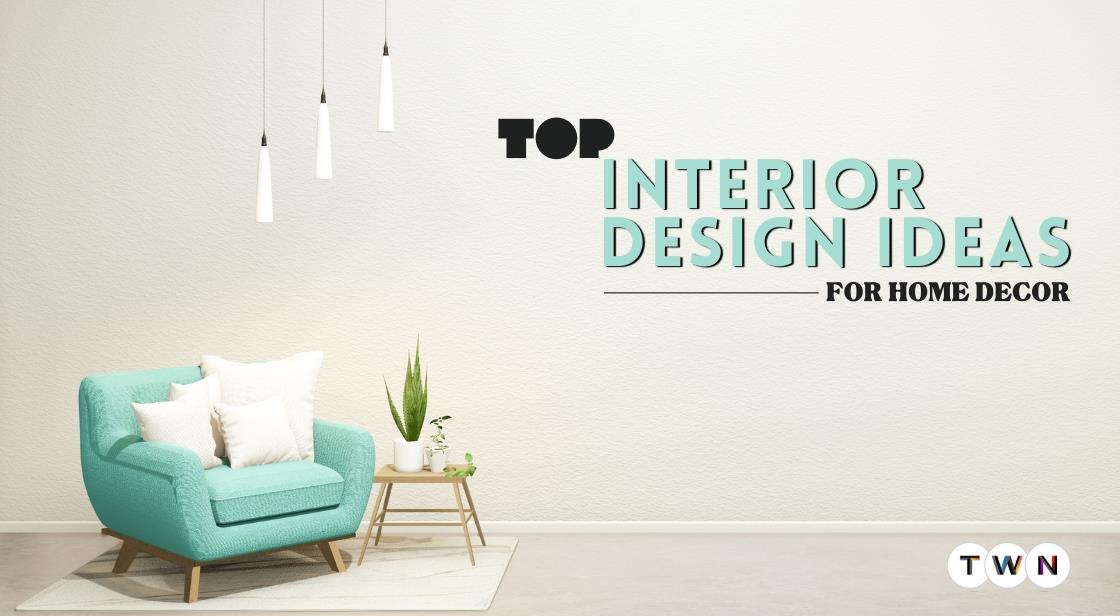Top Interior Design Ideas for Home Decor

Blog Post
When it comes to transforming your house into a warm and inviting home, interior design is the key to unlocking its full potential. Your choice of colors, furniture, and decor can shape the ambiance and style of your living space.
Whether you're moving into a new residence or looking to refresh your current one, this article is your guide to the top interior design ideas that can help you create a captivating and welcoming atmosphere.
Interior design is the art and science of enhancing the interior of a building to achieve a healthier and more aesthetically pleasing environment for the people using the space. An interior designer is someone who plans, researches, coordinates, and manages such enhancement projects.
From embracing the wonders of smart home technology to the creative use of whimsical decor, we'll explore how to infuse your living space with personality and style.
Additionally, we'll delve into the art of repurposing, elevating minimalism, and using natural materials and textures to bring the beauty of the natural world into your home.
Get ready to explore the world of interior design and discover how to make your space truly your own.
When it comes to making your house truly feel like home, interior design plays a pivotal role. Your choice of colors, furniture, and decor can significantly impact the ambiance and style of your living space.
Whether you're moving into a new home or looking to refresh your current one, this article presents the top interior design ideas to help you achieve a captivating and inviting atmosphere.
Smart Home Technology: The Benefits and How to Get Started
Smart home technology is a rapidly growing field that encompasses a wide range of devices and systems that can be interconnected to automate and control various aspects of your home. From lighting and climate control to security and entertainment, smart home technology can make your life more convenient, efficient, and enjoyable.
Some of the most popular smart home devices and systems include:
-
Smart speakers and voice assistants: These devices allow you to control your smart home devices with your voice, making it easy to turn on the lights, adjust the thermostat, or play music without having to lift a finger.
-
Smart thermostats: Smart thermostats can learn your heating and cooling preferences and adjust the temperature accordingly, helping you save energy and money on your utility bills.
-
Smart lights: Smart lights can be controlled remotely using an app or voice assistant, and can also be programmed to turn on and off automatically at certain times of day.
-
Smart security systems: Smart security systems can send you alerts if there is an intrusion into your home, and can also be used to remotely control your locks, lights, and cameras.
-
Smart home security cameras: Smart home security cameras can be used to monitor your home remotely, and can also send you alerts if they detect any movement or activity.
-
Smart doorbells: Smart doorbells allow you to see and speak to visitors at your door remotely, even if you're not home.
-
Smart locks: Smart locks allow you to lock and unlock your doors remotely using an app or voice assistant.
-
Smart appliances: While smart appliances often conjure images of futuristic kitchens and living rooms, their reach extends far beyond the TV Stands & Entertainment Centers. From refrigerators and washing machines to ovens and thermostats, the world of smart appliances is transforming the way we interact with our homes, bringing convenience and efficiency to every corner.
Smart home technology can be integrated into your home in a number of ways. Some devices and systems are easy to install yourself, while others may require professional installation. You can also choose to integrate your smart home devices and systems with a central hub, which can make it easier to control and manage them all from one place.
Here are some of the benefits of integrating smart home technology into your home:
-
Convenience: Smart home technology can make your life more convenient by automating tasks that you would otherwise have to do manually. For example, you can program your smart lights to turn on when you arrive home at night or your smart thermostat to adjust the temperature when you're away.
-
Efficiency: Smart home technology can help you save energy and money by automating tasks that can be inefficient, such as heating and cooling your home or running your appliances.
-
Security: Smart home technology can help you keep your home safe by monitoring for intruders and sending you alerts if there is a problem.
-
Peace of mind: Smart home technology can give you peace of mind knowing that you can check on your home and control your devices remotely, even when you're not there.
If you're interested in integrating smart home technology into your home, there are a few things you can do to get started:
-
Identify your needs and goals. What do you want to achieve by integrating smart home technology into your home? Do you want to save energy, improve security, or simply make your life more convenient?
-
Once you know your needs and goals, you can start to research specific devices and systems that can help you achieve them.
-
Consider your budget. Smart home technology can range in price from affordable to expensive. Setting a budget prior to commencing your shopping is crucial to ensure that you do not exceed your spending limits.
-
Do your research. Read reviews and compare different devices and systems before you make a purchase. It's also important to make sure that the devices and systems you choose are compatible with each other.
-
Start small. You don't have to integrate all of your smart home devices and systems at once. Start with a few key items and add more as needed.
-
Get professional help if needed. If you're not comfortable installing smart home devices yourself, you can hire a professional to help you.
Top Interior Design Ideas for Home Decor
Embracing Whimsy in Home Decor
Whimsy isn't exclusive to children's rooms. While whimsical wallpapers are often preferred for their role in aiding brain development and offering comfort to little ones, they have a unique charm that can make any room more engaging and lively. The key is to strike a balance – you don't need to go all-in with eccentric designs featuring crazy ducks or talking chimps. Instead, opt for something that resonates with your personal style while injecting that much-needed X-factor into your interior decorating ideas.
Ditching Conventions
In the realm of home decor, whimsy allows you to break free from conventions and experiment with creativity. It's all about infusing your living space with elements that evoke a sense of delight, surprise, and imagination. You can add a touch of playfulness through the choice of furniture, accessories, or, in our case, whimsical wallpapers.
Choosing Whimsical Wallpapers
Whimsical wallpapers come in a delightful array of designs, and the possibilities are limited only by your imagination. Here are a spme ideas to get started:
-
Nature-Inspired Whimsy: Opt for wallpapers featuring vibrant, oversized flowers, playful animals, or enchanted forests. These designs can bring a touch of the outdoors inside and lend a sense of wonder to your living space.
-
Geometric Whimsy: Geometric patterns infused with whimsical elements like colorful shapes or abstract motifs can add an unconventional and contemporary twist to your decor.
-
Childhood Nostalgia: Remember the stories and characters that made your childhood special? Incorporate them into your decor with wallpapers that feature beloved cartoon characters, fairy tales, or classic children's book illustrations.
-
Subtle Whimsy: If you prefer a more understated whimsical touch, look for wallpapers with subtle, unexpected details. These might include a hidden message, whimsical texture, or an artistic, quirky design that reveals itself on closer inspection.
Creating a Focal Point
Whimsical wallpapers work exceptionally well as a focal point in a room. Whether it's a feature wall in your living room, a creative backdrop for a home office, or a playful surprise in a guest bedroom, these wallpapers can spark conversations and leave a lasting impression.
Blending with Your Style
The beauty of whimsy is its versatility. You can seamlessly incorporate whimsical elements into different interior design styles, whether you lean towards modern, traditional, or eclectic. The key is to ensure that the whimsical wallpaper you choose resonates with your personal taste and complements the overall decor of the room.
Renew and Reimagine: Unleash Your Creative Side in Home Decor
You've probably heard the saying, "One man's junk is another man's treasure." Well, when it comes to home decor, you don't need to rely on someone else's cast-offs. Instead, look at the items you already have, whether it's old furniture, a stash of wood pellets, discarded curtains, or worn upholstery, and consider repurposing them to breathe new life into your living space.
The Art of Repurposing
Repurposing is all about reimagining the potential of items that may seem past their prime. It's a fantastic way to create unique, eco-friendly decor pieces and add a touch of personal flair to your home. Here are a few ideas to get your creative juices flowing:
1. Salvage Wood Projects: Have old wooden boards, pallets, or discarded furniture lying around? Don't toss them out – transform them into something remarkable. One exciting project is to craft a rustic coffee table using reclaimed wood. Sand it down, apply a fresh finish, and voilà! You've given new life to something old.
2. Upholstery Revival: Got a worn-out side table that you're thinking of replacing? Hold that thought. Consider reupholstering it instead. Find some quality linen or vibrant fabric, add comfortable cushions, and give your old side table a charming makeover. It's a sustainable way to infuse your decor with a touch of elegance.
3. Curtain Call: Discarded curtains can find a new purpose beyond the windows. With a bit of creativity and a sewing machine, you can repurpose them into unique pillow covers, table runners, or even a stylish room divider. This not only reduces waste but also adds a distinct touch to your decor.
4. Innovative Storage Solutions: Unused wooden crates, vintage suitcases, or wooden pallets can be transformed into stylish and functional storage solutions. Stack them to create a one-of-a-kind bookshelf, or repurpose an old ladder into a chic storage unit. These DIY projects not only enhance your decor but also optimize your space.
5. Frame Your Memories: Old frames can be reinvented with a fresh coat of paint or a distressed finish. Then, use them to showcase your cherished memories or as stylish mirrors. It's an artistic way to add character to your walls.
The Power of DIY
When it comes to repurposing, a little DIY effort can go a long way. Not only does it save you money, but it also allows you to infuse your home with pieces that have a unique story to tell. The best part? You don't need to be a crafting expert to embark on these projects. The internet is brimming with DIY tutorials and ideas, making it accessible to all.
Also Read : Best Interior Design Tips for Stunning Home Decor
Elevate Your Space with Wall Art: The Creative Essence of Home Decor
We all understand the transformative power of art – how it can breathe life and character into any room. The good news is that you don't need to break the bank to adorn your home with exquisite wall art. A touch of creativity and a willingness to experiment can go a long way in making your living space truly unique.
The Art of Expression
Consider this: you can turn your walls into a canvas of self-expression. If you've ever strolled through the streets of New York, you've likely encountered the mesmerizing murals that adorn tunnels and even entire streets. It's an inspiring sight, and you can replicate that magic within your own space. Don't be daunted by your perceived lack of artistic prowess – even without professional training, you can create captivating artwork.
DIY Mural Magic
If the idea of painting your own mural appeals to you, seize the opportunity to infuse your home with your personal touch. You don't need to aim for a grand spectacle; a mural can be as large or small as you desire. A vibrant abstract design, a soothing landscape, or an inspirational quote – your mural can be a reflection of your style and imagination.
If the prospect of wielding a paintbrush is outside your comfort zone, fear not. The art world is a vast realm, and you can acquire captivating pieces without ever touching a brush. Attend auctions or explore local art communities to discover works that resonate with you. Investing in the creations of budding artists not only brings a unique personality to your decor but also supports the artistic journey of talented individuals.
More Than Brushwork: The Essence of Personality
In the world of wall art, it's not the brushwork that truly matters; it's the personality it imparts to your space. Each stroke or acquisition tells a story, reflecting your taste, experiences, and the essence of your home. Your walls become a testament to your creative spirit and the memories you wish to preserve.
Wall art also serves as a conversation starter, offering guests a glimpse into your world and your interpretation of beauty. Whether it's a handmade mural or a carefully chosen piece from a local artist, every artwork contributes to the tapestry of your decor. It's the personal touch that sets your home apart.
Elevate Minimalism: Craft a Captivating Focal Point for Your Home
Minimalism, characterized by simplicity and functionality, is a design approach that doesn't shy away from elegance and exclusivity. In fact, it's in the minimalist style that every element of your decor becomes an essential statement. There's no need for clutter or excess; instead, you can celebrate the cherished items that add personality to your space. Even within a minimalist theme, you have the opportunity to curate a focal point that showcases your most cherished possessions.
The Art of Minimalist Luxury
Minimalism is not about deprivation; it's about discernment. It's the belief that less can be more, that quality outshines quantity. This philosophy allows you to enjoy simple living while highlighting exceptional items in your home. By adopting this approach, you can balance the elegance of exclusivity with the principles of minimalism.
Celebrating Treasured Possessions
Imagine you've created a serene ambiance in your living space, and your decor is the epitome of understated sophistication. Within this clean and uncluttered environment, there's ample room to spotlight the "really good stuff." It could be a handmade masterpiece crafted at a local woodshop, an exquisite painting gifted by your spouse from their travels, or an antique breakfront that you've acquired.
These cherished possessions deserve their moment in the spotlight. To do so, create a dedicated section or a specific arrangement that serves as the focal point of your room. This strategic placement can be subtle, yet it elevates the significance of these items and commands attention.
Crafting a Focal Point
Designing a focal point in a minimalist setting is an art in itself. It requires a delicate balance between restraint and emphasis. Here's how you can master this art:
-
Select Your Masterpiece: Choose the item that holds the most significance to you. It could be a piece of art, an intricately designed piece of furniture, or an object with a rich history.
-
Strategic Placement: Position this centerpiece thoughtfully. It could be a corner display, a dedicated shelf, or a carefully designed wall arrangement.
-
Lighting Magic: Illuminate your focal point with the right lighting. Subtle spotlights or adjustable wall fixtures can draw attention without overwhelming the space.
-
Complementary Surroundings: Ensure that the area around your focal point is harmonious. Minimalist decor allows your chosen piece to shine. Opt for neutral colors, unobtrusive furniture, and subtle textures to maintain the serenity of your space.
Elevate Your Interior with Bold Accent Shades on Window Frames
When it comes to infusing life and character into your living spaces, accents are a powerful tool. But who says accents should be confined to accessories? Think bolder, think bigger. Consider the transformative magic of paint. By adorning your window frames, reveals, and shutters with vibrant and daring colors, you're not just making a design statement; you're orchestrating a symphony of light and views. Melanie Griffiths, the insightful Editor of Period Living magazine, and a valued contributor to Homes & Gardens, extols the virtues of this approach.
A Window into Artistry
Let's embark on this creative journey and discover how painting your window frames can revolutionize your living space:
1. The Striking Design Feature:
Window frames are often overlooked in the design process. However, they possess the potential to be the pièce de résistance of your interior. By painting them with a bold and captivating color, you can transform them into a captivating design feature. This vivid choice will not just capture attention but also evoke a sense of wonder.
2. Amplifying the View:
Imagine your window frames acting as an exquisite frame for the world outside. The bold color not only draws the eye but also amplifies the beauty of the view. It's like having a constantly changing work of art on display.
3. A Play of Light:
Colors have the power to influence the way light behaves. A strong and daring shade on your window frames can change the ambiance of a room. It can make the light more dramatic, casting enchanting shadows and highlights. Each moment of the day becomes a distinct scene in your personal theater.
4. Choosing the Perfect Hue:
The beauty of this approach is its versatility. You have the freedom to select the shade that resonates with your aesthetic. Are you drawn to the warmth of on-trend terracotta, creating a cozy and inviting atmosphere? Or perhaps you prefer the vibrancy of sunny yellow, capable of brightening even the gloomiest of days. The choice is yours.
5. Dado Atelier's Terracotta Elegance:
For an inspiration rooted in the contemporary and the cozy, look no further than Dado Atelier. Their use of terracotta as a window frame accent is a testament to the warmth and charm this color can bring to your living space. It's the choice to create an atmosphere that envelops you like a comforting embrace.
6. Sunshine in the Darkest Hours:
And then there's the exuberance of sunny yellow. This choice is a beacon of light on even the cloudiest days. Your space is bathed in optimism and energy, with your window frames becoming the portal to an eternal sunrise.
Add Trim to Curtains and Cushions for a Designer Touch
Trim can add a touch of elegance and sophistication to any room. When used on curtains and cushions, it can also help to tie a space together and create a cohesive look. There are many different types of trim available, so you can find the perfect style to match your décor.
Benefits of Adding Trim to Curtains and Cushions:
-
Adds interest and detail: Trim can add a touch of interest and detail to curtains and cushions, making them look more polished and finished.
-
Ties a space together: Trim can help to tie a space together by creating a visual connection between different elements of the room.
-
Can be used to hide imperfections: Trim can be used to hide imperfections in curtains and cushions, such as uneven edges or frayed seams.
-
Protects the fabric: Trim can help to protect the fabric of curtains and cushions from fraying and wear and tear.
Types of Trim for Curtains and Cushions:
There are many different types of trim available for curtains and cushions, including:
-
Braids: Braids are a classic type of trim that can be used to add a touch of elegance to any room. They are available in a variety of materials, colors, and patterns.
-
Fringes: Fringes are a fun and flirty type of trim that can add a touch of whimsy to your décor. They are available in a variety of materials, colors, and lengths.
-
Pom-poms: Pom-poms are a playful and colorful type of trim that can add a touch of fun to any room. They are available in a variety of materials, colors, and sizes.
-
Rickrack: Rickrack is a zig-zagged type of trim that can add a touch of whimsy or sophistication to your décor, depending on the material and color you choose.
-
Ruffles: Ruffles are a romantic and feminine type of trim that can add a touch of softness and elegance to your décor. They are available in a variety of materials, colors, and sizes.
How to Choose the Right Trim:
When choosing trim for your curtains and cushions, there are a few factors to consider:
-
The style of your décor: The type of trim you choose should complement the style of your décor. For example, if you have a traditional décor, you might choose a classic braid or fringe trim. If you have a more contemporary décor, you might choose a more modern trim, such as ric-rac or a pom-pom trim.
-
The color of your curtains and cushions: The trim you choose should contrast with the color of your curtains and cushions to create a visual impact. For example, if you have white curtains, you might choose a navy blue trim to add a touch of color and drama.
-
The scale of your curtains and cushions: The scale of the trim you choose should be in proportion to the scale of your curtains and cushions. For example, if you have large curtains, you might choose a bolder trim. If you have small cushions, you might choose a more delicate trim.
How to Attach Trim to Curtains and Cushions:
There are a few different ways to attach trim to curtains and cushions. One popular method is to use hot glue. Another popular method is to sew the trim on by hand or with a sewing machine.
Tips for Attaching Trim to Curtains and Cushions:
-
Measure twice, cut once: Before you start attaching the trim, be sure to measure your curtains and cushions carefully. This will help you to ensure that you have enough trim and that it is cut to the correct length.
-
Use a straight edge: When attaching the trim, use a straight edge to help you keep the trim in line. This will help to ensure that the finished product looks neat and professional.
-
Secure the trim at the ends: Once you have attached the trim, be sure to secure the ends to prevent them from fraying. You can do this by sewing the ends of the trim or by using hot glue.
Use Natural materials and textures
Natural materials and textures are a timeless and versatile way to add warmth, organic appeal, and a sense of connection to nature to your home decor. From wood and stone to bamboo and rattan, there are many different natural materials to choose from, each with its own unique properties and aesthetic.
Wood is one of the most popular natural materials for home decor, and for good reason. It is durable, versatile, and comes in a wide range of colors and finishes. Wood can be used to create a variety of furniture pieces, from dining tables and coffee tables to bed frames and bookshelves. It can also be used for flooring, wall paneling, and accent pieces such as trays and bowls.
Stone is another popular natural material for home decor. It is known for its strength, durability, and timeless beauty. Stone can be used to create a variety of countertops, backsplashes, and flooring options. It can also be used for fireplaces, accent walls, and outdoor features such as patios and walkways.
Bamboo is a sustainable and versatile natural material that is becoming increasingly popular for home decor. It is lightweight, strong, and durable, making it a good choice for a variety of furniture pieces, including chairs, tables, and beds. Bamboo can also be used for flooring, wall panels, and blinds.
Rattan is another popular natural material for home decor. It is known for its lightweight, airy appearance and its ability to add a touch of boho or coastal style to any space. Rattan can be used to create a variety of furniture pieces, including chairs, tables, and baskets. It can also be used for mirrors, headboards, and other accent pieces.
Here are some specific ideas for how to incorporate natural materials and textures into your home decor:
-
Use wood furniture to create a warm and inviting space. A wooden dining table, coffee table, or bed frame can be a focal point for any room. You can also add wooden accents such as shelves, trays, and bowls to add warmth and texture.
-
Add a stone countertop or backsplash to your kitchen for a touch of luxury. Stone is a durable and stylish material that can elevate the look of any kitchen.
-
Install bamboo flooring for a sustainable and eco-friendly option. Bamboo is a fast-growing renewable resource, and it is also a very durable material.
-
Add rattan furniture or accents to your home for a boho or coastal vibe. Rattan is a lightweight and airy material that can add a touch of personality to any space.
-
Incorporate natural textures into your home decor with textiles such as linen, cotton, and wool. These natural materials are soft, breathable, and inviting. You can use them for curtains, bedding, towels, and throw pillows.
Additional tips for using natural materials and textures in your home decor:
-
Mix and match different natural materials to create a unique and eclectic look. For example, you could pair a wooden dining table with rattan chairs and linen placemats.
-
Use natural materials to create a sense of balance and harmony in your home decor. For example, you could ground a space with a stone fireplace or add a touch of softness with linen curtains.
-
Don't be afraid to use natural materials in unexpected ways. For example, you could use a bamboo tray as a coffee table or a rattan mirror as a wall accent.
By incorporating natural materials and textures into your home decor, you can create a space that is both stylish and inviting.
Conclusion
Incorporating these top interior design ideas into your home decor can breathe new life into your living space. Experiment with different elements and styles to create an interior that is not only stylish but also a true reflection of your unique personality. Whether you're looking for a serene and minimalistic ambiance or a vibrant and eclectic atmosphere, these ideas can help you achieve your desired home decor style.
You May Like
EDITOR’S CHOICE












